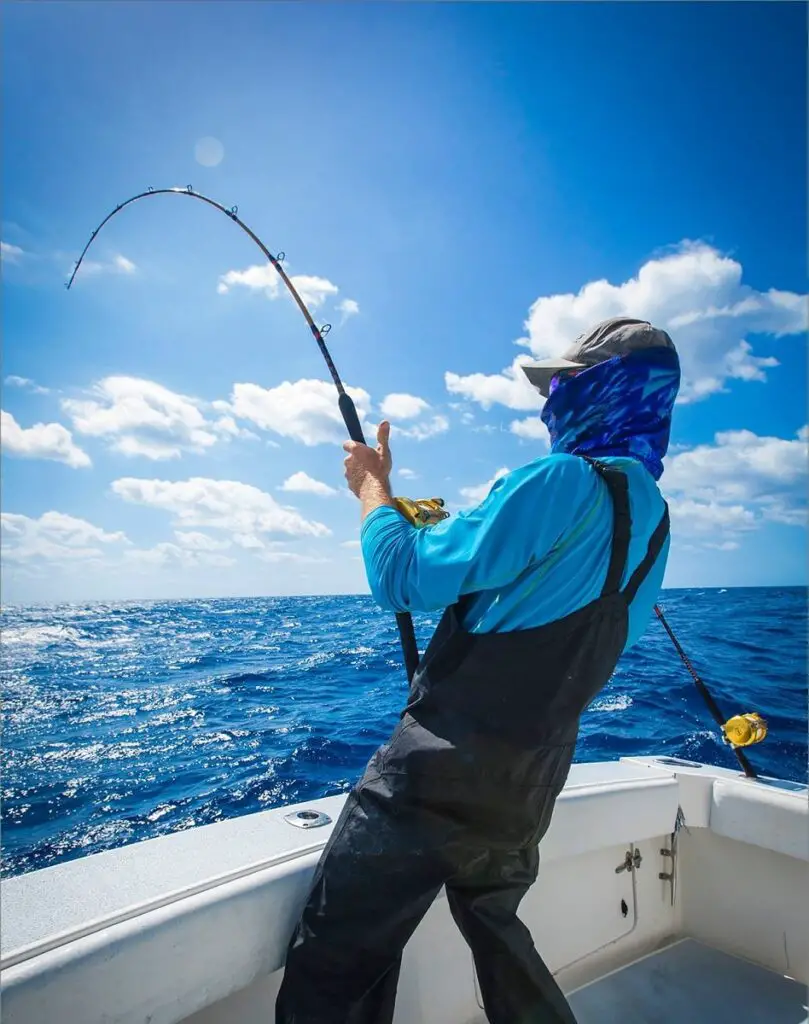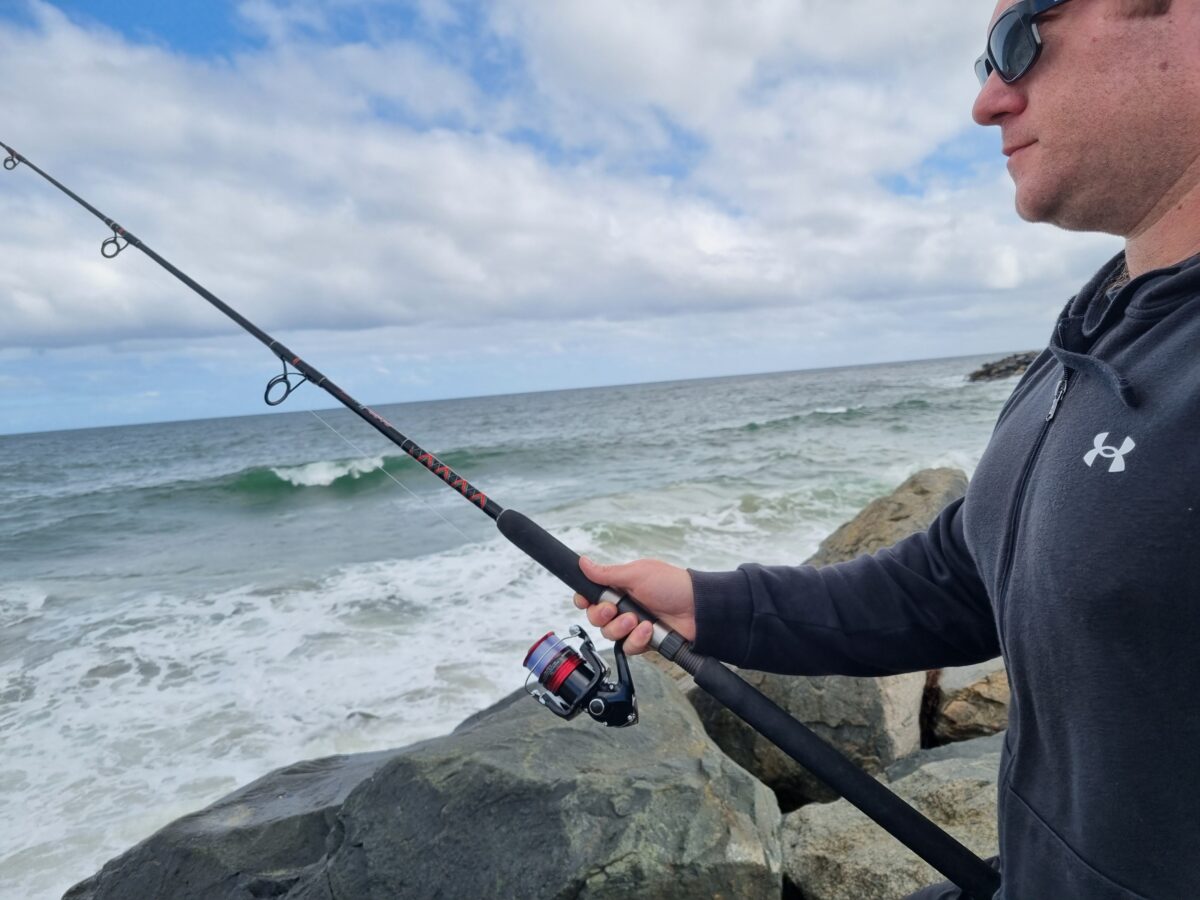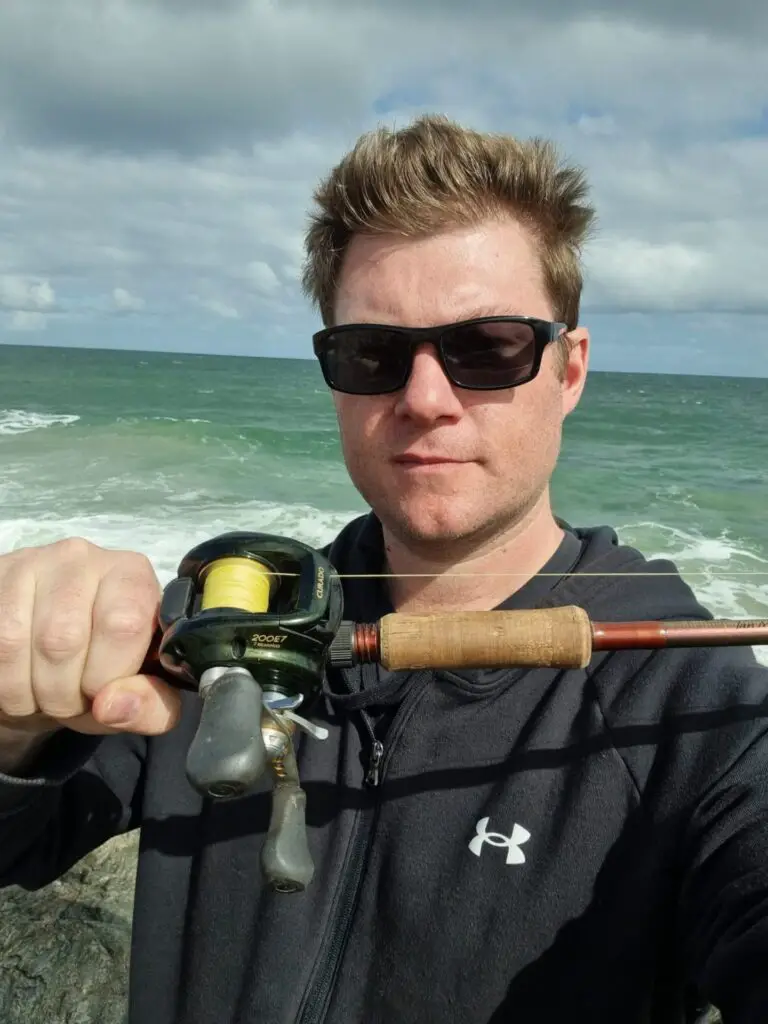Essential fishing gear includes a rod and reel, tackle box, various hooks, lures and bait, fishing line, pliers, a knife, bobbers, sinkers, swivels, a tape measure, a net, and polarized sunglasses. Additionally, owning a hat, sunscreen, and proper clothing ensures comfort and safety while fishing.

Fishing offers some uniquely satisfying and refreshing experiences. It is a fantastic way to escape busy city life and create good memories with family and friends. However, please remember that the gear you carry can make a lot of difference in your fishing.
Anglers can use numerous pieces of equipment to improve their fishing experience. While what you choose to carry is a subject of personal preference, it is imperative to have at least the basic fishing items.
In this, we’ve prepared a list of essential fishing gear every angler should own, regardless of the fish species they are targeting.
Table of Contents
Essential Fishing Gear
Fishing rod and reel
Of course, that’s obvious. Fishing rods get baits or lures into the water with top-notch precision. You will find rods for specific angling needs, such as fly fishing, bait fishing, reef fishing, spinning, and trolling fishing. Focus on getting a quality fishing rod based on the type and size of your target fish species.
You can also get a few rod socks to protect your valuable rods during transport especially if they ae graphite which can be vulnerable to impact damage.
Fishing reels are attached to rods. They allow anglers to cast baits or lures at great distances. With the reels, you can fish even in deep water and retrieve your catch safely. Make sure you experiment with the different types of reels to find what fits your fishing style.
You should also consider a reel cover to protect your valuable gear all you round.

Fishing lures
Lures make catching fish a lot easier, and they are fun to use. They often than not hook fish in the mouth, lips, or jaws, and this facilitates a safer catch and release.
You are spoilt for choice when it comes to artificial fishing baits. Lures are available in different sizes, shapes, colors, and movements, each designed for specific fish species.
For example, if you’re targeting panfish, smaller jibs and grubs can be an effective lure option. Bigger fishes like bass and pike will require larger fishing lures, such as crankbaits (plugs) or spinnerbaits.
It is up to you to decide what to use. However, the best course of action is to have a collection of lures you can easily interchange to target a wide range of species more accurately.
Set of pliers
Sometimes it not easy to pull out hooks cleanly by hand. In such a case, you will need a good set of fishing pliers. Anglers are advised to invest in a set of pliers that cuts through every type of line they’ll be using, from monofilament and braided to fluorocarbon and copolymer.
The ideal nose length you choose depends on the type of fish you’re targeting. This can be a tricky decision. Generally, though, fishing pliers with a 6-7” needle nose will get the job done. For big, toothy fish varieties, you will need slightly long nose pliers, preferably 8” or longer.
If you don’t have a good set of pliers then you can use a multitool for fishing that comes with a selection of features.
Filleting knife
Every serious angler needs a fillet knife. While you can clean fish with almost any type of kitchen knives, none beats the filleting knife. It is a super sharp knife that allows you to remove skin, bones, entrails, and fins more quickly, safely, and efficiently. Using your old kitchen knife will probably waste a heap of fish.
Cooler
Keeping your catch fresh is essential to making sure you get as many fillets as you can. This helps to avoid overfishing and keep your freezer full all year round. A high quality cooler goes a long way.
Bait Cast Net
A nice to have is a cast net for catching your own bait. If you are fishing often then this is a great money saver. Instead of buying bait every week you can just go out and catch your own. This is often more effective bait as the local fish are already targeting them.
Tackle box essential gear
A fishing tackle box or fishing backpack can be stocked up with different types of gears, depending on the fish species you’re planning to catch. Contents of a tackle box can vary, but here’s what you should never forget when packing for your next fishing trip.
Spare fishing line
Carrying an extra fishing line is a must because things can go wrong when fishing. For instance, your new line can get tangled up. If you are using an old fishing line in rough conditions, it can break. Whatever the case, you don’t want to cut your trip short because of a fishing line.
Lip Grips
If you are fishing for a species that has teeth or sharp jaws then you will want to get yourself a good set of lip grippers.
Spare terminal tackle
The main categories of essential terminal tackle include:
Hooks
Consider having hooks of different sizes, regardless of the type you choose. Not because you’re bound to lose hooks so often when fishing, but it makes you better prepared for all sorts of fish.
Sinkers
Sinkers or weights are attached to a fishing rig to sink a hook or lure into the water. There are sinkers designed for shallow water and deep-sea fishing. They come in innumerable shapes for diverse fishing applications.
Floats
Floats are another essential fishing gear to include in your tackle box, as they help you know when the fish starts to nibble at your bait. They keep your bait suspended in deep water at the perfect depth. They will go under in case of a strike, indicating that you should reel your catch in.
Swivels and snaps
Don’t forget swivels and snaps too! They reduce the risk of your fishing line twisting and tangling. Swivels can also stop a sliding sinker, whereas snaps allow anglers to change the rigs easily and quickly.
Split rings
Split rings increase the mobility of your hook or lure. They get connected between a lure or hook.
Protective equipment
Since you will be spending a lot of time outdoor, it is a great idea to protect yourself from the sun’s harmful rays. Water bodies will reflect some of the rays at you, causing an agitating glare. So, next time you head out to fish, make sure to include the following protective equipment in your fishing gear.
Polarized sunglasses
Polarized sunglasses are the most preferred essential piece of gear to reduce glare and protect your eyes from the damaging ultraviolet light (UV) rays. With this specialized eyewear, you will see more clearly and avoid some potential hazards.

Sunscreen
Never miss a bottle of sunscreen in your tackle box. Applying sunscreen to exposed body parts is highly recommended to prevent sunburns. Ideally, you should wear sunscreen with an ultraviolet protection factor (USF) of at least 15.
Hat
Wearing a fishing hat essentially covers you from the UV rays, protecting you against burns. It can also protect your eyes from the potentially blinding glare.
Headlamp
If you intend to fish at night or at dusk then you will certainly need to get a powerful headlamp. This is both so you can see your fishing reel for tying knots but also to make your way back to your truck after you are done.
Radio
If you are fishing alongside a fellow angler in a separate boat then a marine radio is essential for communicating. It is also crucial when going offshore for safety.
Nice to Have
Not everything is essential. Some gear just makes life more comfortable and enjoyable.
Bite Indicator
Bite indicators are attached to your line and give off an alarm when a fish strikes. This allows you to put your rod in a rod holder and walk away for a short time. This is ideal so that you can cook, set up camp, go to the bathroom, or deal with a second line without taking your bait out of the water.
Fish Scales
There is no better feeling than bragging to your friends about a trophy fish after you have caught it… but its even better if you can confirm the weight of your fish with a set of digital fish scales. Then there can be no doubt.
Fishing Gaff
If you are fishing for something large, especially offshore, then you will want to get a gaff. This helps to land large saltwater species.
Fighting Belt
Another big game accessory is a fighting gimbal belt. This is primarily used for game fish like Marlin or Sailfish that can fight for hours. While it might be a ‘nice to have,’ if you hook a Marlin it becomes essential.
Dry Bag
The first time you drop your smart phone is when you realize a dry bag is essential. This is especially important if you are likely to get wet, such as kayak fishing or wading fly fishing.
Hook Remover
Fish with tough jaws can often get a hook stuck that needs to be removed. They can also swallow a hook into their gullet that can be difficult to remove. A good hook remover tool can help.
Line Spooler
If you are frequently changing fishing lines then you will need a spooler tool. This means that you can cleanly spool up your used line and easily put your new line on.
Rod Holder
There are plenty of different rod holders on the market depending on where you are fishing – from a boat, off the bank, at the beach, and anywhere in between.
Drift Anchor
If you are fishing in deep water then a drift anchor is a nice addition to any angler’s boat. This allows you to slow the boat from the current without needing to lower hundreds of feet of rope.
Conclusion
If you have all the above fishing equipment, it is safe to say you’re ready for the next fishing trip. But one last thing to remember; fishing is not always about making a catch. Take the opportunity to enjoy the beautiful scenery and tranquillity of the still waters.
If you want a great printable essential fishing gear checklist, then have a look at this.
If you have any other pieces of equipment that should be on this list then please leave a comment below so that we can share it with our audience.
Happy fishing!
